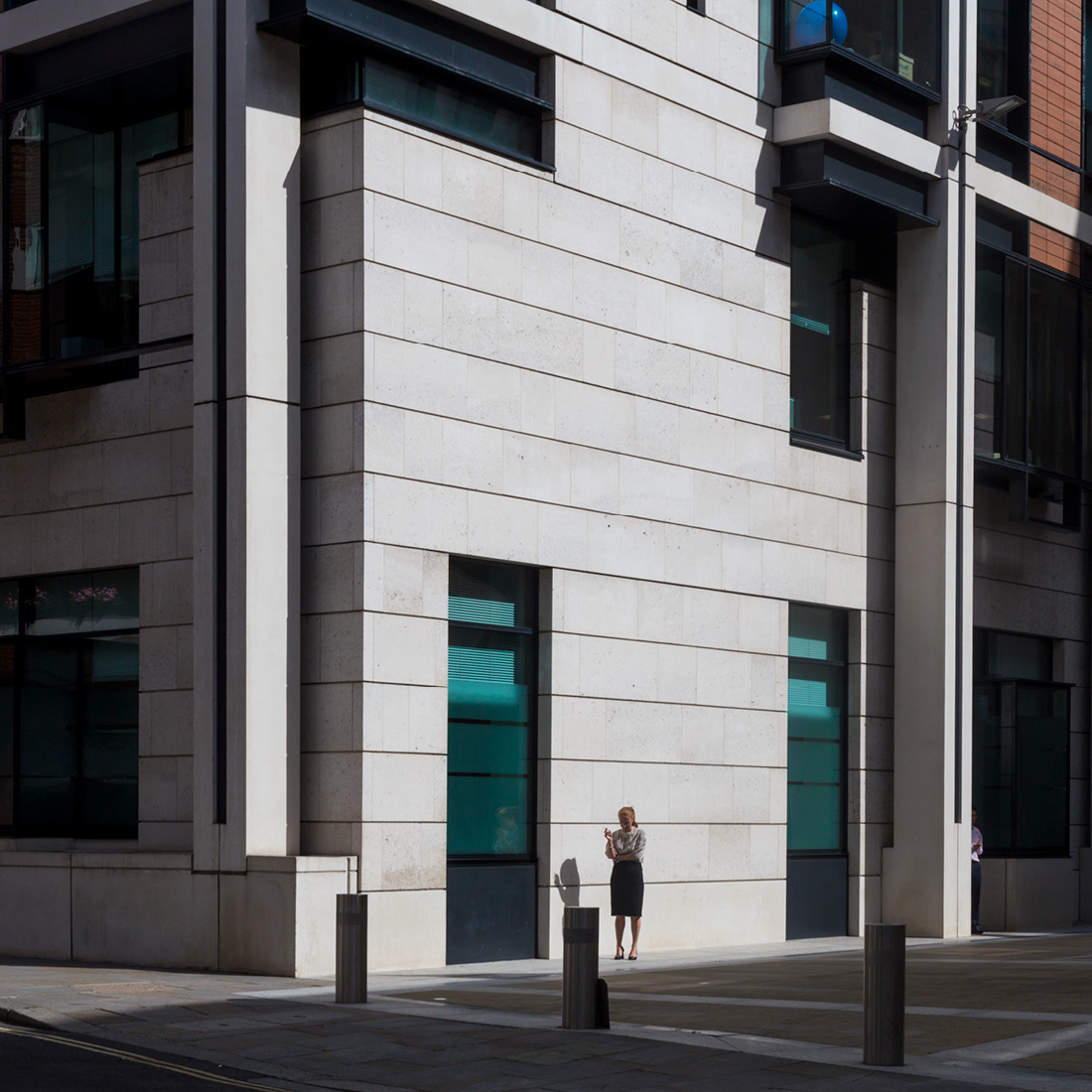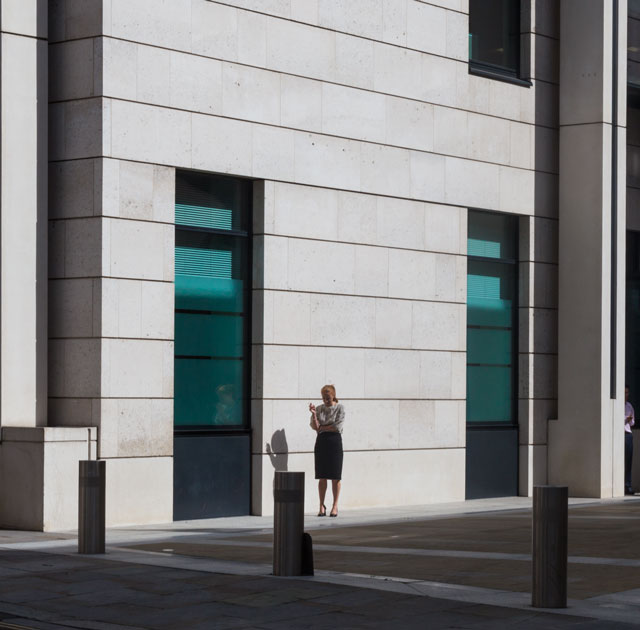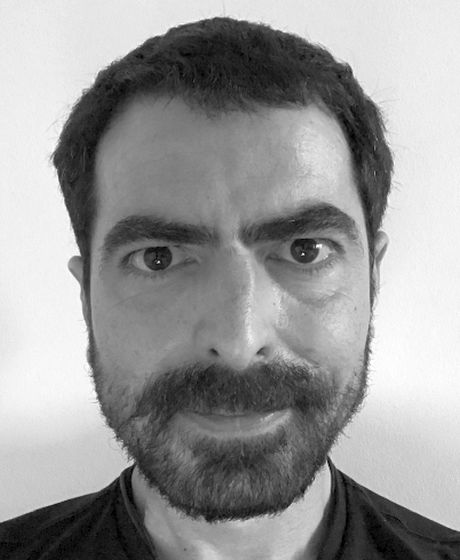Jordi Barreras’ work begins with photojournalism and ends up as auteur documentary photography, under the influence of artists such as Martha Rosler. When the economic crisis hit, Barreras stopped working for national newspapers and emigrated to London, where he embarked on a photography project on the City of London Corporation, one of the world’s leading financial districts. Its layout coincides at some points with the space occupied by the old medieval wall, and becomes the symbol of economic dominance. The 22 photographs featured in the book Already But Not Yet are the product of five years’ work. With imposing architecture as a powerful backdrop, they show the isolation and vulnerability of those who live subjected to extreme competitiveness and motivational strategies, with promises of success that never end up materialising.

The title of this book, Already But Not Yet, is reminiscent of a theological concept, that of the kingdom of God which is both present and future: we are already part of it (already), but it will not be fully realised until the future (but not yet). The tension between this “now” and a “not yet” creates a sense of expectation and mood of suspension, which the photographer strives to capture in the style of Edward Hopper’s paintings. The camera records a time when nothing seems to be happening, when the characters on break are in search of a ray of sunshine, caught in the middle of a day that is set to be long and gruelling. They have been told that, even if conditions are precarious, if they persevere in their efforts, they will accomplish their goals. To exert oneself means, in this case, self-exploitation, as the philosopher Byung-Chul Han explains in his book The Burnout Society. No one can guarantee that the road to success will not be cut short by a disciplinary action or a sudden dismissal. The monotony of the moment is only interrupted by the longing for the situation to improve, but patience is required. As the beatitudes say, “blessed are the meek, for they shall inherit the earth”. Capitalism appropriates this idea to feed a new materialistic religion built on the promise of future gain by sacrificing the present. It is not by chance that in today’s metropolises, the tallest buildings are no longer cathedrals or churches, but the headquarters of big corporations that compete with each other to have the tallest building and thus prove their symbolic domination over the territory.
The comments accompanying these images are based on the texts of Flavia Loscialpo and Stephanie Schwartz included in the book.
©Jordi Barreras
These images focus on the isolated subject, all alone surrounded by the imposing buildings that symbolise the power structures of global capitalism. The very title of the book itself conveys the meaning of the message: workers are “already” part of neoliberal mechanisms, “but not yet” have they come to the end of their realisation, which is never complete and always looks to the future. There is a clear political intention in the image composition: the isolation of the subject is set against a background of fragmentation and the atomisation of life, the erosion of community, growing deregulation, productivity and endless workloads. According to the philosopher Byung-Chul Han, we have moved from the “disciplinary society” to the “performance society”, in which individuals must embody attributes such as adaptability, flexibility, versatility, proactivity and initiative to succeed. Driven by the need to perform, they are susceptible to unlimited availability. In effect, they subject themselves to a regime of self-exploitation. Neoliberal strategies of subjugation work through the internalisation of power, and its manifestations are the fear of not achieving anything, burnout, constant tiredness and depression.
©Jordi Barreras
The strange moments of isolation depicted in London’s bustling financial hub reveal the state of the neoliberal subject. In the city, which has a networking role, individuals are constantly connected, proud to be busy, yet isolated when faced with the demands of performance and power structures. The towering, dominating presence of skyscrapers is an allegory of the clout held by economic and corporate powers, and the subordination of individuals. Besides the architecture, the other expressive feature is light, which subtly shows the subject’s position in relation to power structures. While the individual is always caught by this light, the buildings remain mostly in semi-darkness. This suggests that power and its forms of control are (usually) hidden. The position chosen by the photographer is also hidden, observing and operating from the shadows. Barreras’ photographs invite us to reflect on the role and nature of documentary photography, and hint at the crucial fact that, as Michel Foucault states, “where there is power, there is resistance”.
©Jordi Barreras
Banal situations of introspection are presented as a symptom of the ill-functioning system that turns people’s aspirations into a lure to trap them. The most worrying thing is that these people, absorbed in their thoughts, are very much like any of us. Through this critical approach, the author seeks to make reality more comprehensible.
©Jordi Barreras
In Non-Places. Spaces of Anonymity, the French anthropologist Marc Augé introduces the idea of “non-places” as spaces created by “hypermodernity”. These transitory spaces, which human actors pass through anonymously, are contrasted with “places”, which have a profoundly relational and unifying role between social and individual identities. Although perception may be subjective, “non-places” would be defined as spaces to which the individual does not relate intimately and to which the poetics of dwelling do not apply. In Already But Not Yet, the City is representative of many other financial hubs, which are extremely busy during working hours and especially quiet when the offices close. Despite being the workspace of thousands of individuals who spend most of their working day there, the City is eminently a place of passage. Photo by photo, this documentary work unravels the enigmatic relationship between the modern subject and the urban environment, where architecture is not the only dominant factor. Surprisingly, the series was photographed entirely on weekdays before the pandemic, at times when the city was supposedly buzzing.
©Jordi Barreras
The photographs in the Already But Not Yet series are neither intimate nor narrative: they offer a sort of record of the demands placed on those trying to eke out a living in any financial capital. In this environment, what is work? How can it be seen or portrayed? This question is hardly a new one. Cultural critics raised it as early as the beginning of the 20th century, when new industrialisation processes, such as Taylorism, rendered what was once considered to be work unrecognisable. Many suggested that, no longer an occupation or a job, it could no longer be depicted in the same way as before. Several photographers documented this transformation. An iconic example of this is Paul Strand’s Wall Street (1915). In a similar way, Barreras’ images play with the importance of architectural facades, which demarcate the city’s public and private spaces. In Already But Not Yet there is a sense of light and air, but there is no skyline, the individuals seem trapped between the glass giants and the beam of light that illuminates them. This is no coincidence: new cities produce workers and urban spaces come to operate like life-sustaining machines. Strand defined these machines as a “New God”.
©Jordi Barreras
In the words of Allan Sekula, “the documentary genre has simultaneously contributed much to spectacle, to retinal excitation, to voyeurism, to terror, envy and nostalgia, and only a little to the critical understanding of the social world”. Jordi Barreras’ political intentions situate his work in line with these demands of the 1970s. Authors such as Martha Rosler, Jo Spence and Sekula himself advocated the need for a radical change in the genre.
©Jordi Barreras
The critical review of the documentary genre has brought to light its lack of reflection and the lack of works that clearly criticise power structures. Jordi Barreras took his shots waiting for the sunlight to fall on the architectural façades that enclose the City. This waiting for nothing is the antithesis of photojournalism, his former profession.
©Jordi Barreras
L’interès per la fotografia social que professa l’autor neix de la revista Grama, publicació que als anys setanta va representar la veu de les lluites populars i les reivindicacions obreres. Els seus referents locals són Joan Guerrero, fotògraf de Santa Coloma de Gramenet; les imatges de Xavier Ribas a la sèrie Diumenges (1994-1997), o les converses amb Jorge Ribalta sobre fotografia conceptual.
The author’s interest in social photography stems from the magazine Grama, a publication that in the 1970s represented the voice of popular struggles and workers’ demands. His local points of reference are Joan Guerrero, a photographer from Santa Coloma de Gramenet; the images of Xavier Ribas in the series Diumenges [Sundays] (1994-1997); and his conversations with Jorge Ribalta on conceptual photography.
©Jordi Barreras
This work presents the City of London as a dead metropolis, which has surrendered to private interests and has forgotten about public life, but one that is alert because it could be any city in the world. The photographs are a metaphor for a society in which social isolation and individualism prevail over a sense of community. The City is a symbolic example of how power imposes its model of urban planning.
©Jordi Barreras
The newsletter
Subscribe to our newsletter to keep up to date with Barcelona Metròpolis' new developments






